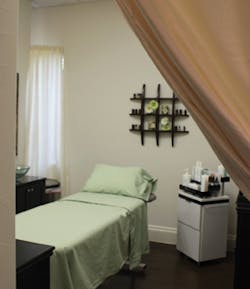What does skin care have to do with dentistry?
BY LISA DOWST-MAYO, RDH
Is there a fountain of youth in this world? After careful research, I know the answer to that question — absolutely not! There are, however, ways to slow the natural aging process of the human body. Hollywood stars such as Jennifer Aniston and Courtney Cox know these tricks very well — no one can tell their actual ages just by looking at them.
Almost every major metropolitan city across the nation now offers dental spas as a choice for patients. I never thought I would find myself working in one of these spas. I am not a tomboy, but I’m also not someone who generally concerns herself with skin care or makeup, or who goes the extra mile for appearance. Fortunately, my husband doesn’t seem to care! I used to say dentistry is for a dental office and facials/waxing are for spas; combining the two is a bad idea. I also used to think neither specialty had anything in common … that is, until I met my current employer, Dr. Tiffini Stratton. It was through her that I found the connection between dental hygiene and skin care. Believe it or not, basic skin care science is directly related to what I do each day. Don’t worry! I do not do facials or hand paraffin waxes while I am scaling teeth! Our spa services are separate from our dental services, and I am not the one providing the spa services.
When Dr. Stratton opened her dental practice, she chose to offer spa services due to a personal experience she had with a local dermatologist. She told me that years ago, she had sought the advice and care of a dermatologist for her minor skin imperfections. The doctor told her the issues she was having were not severe enough to warrant his expertise, and referred her to his front office staff for skin care tips and maintenance. She said these staff members did not have enough education on skin care products to effectively help her. It was through this experience that she decided to partner her practice of evidence-based dentistry with evidence-based skin care. She also wanted to offer a relaxing atmosphere for her dental patients, and by sharing a wide range of spa services, she is able to do just that.
Dr. Stratton believes dentistry and skin care have a direct link to each another, and now I understand the connection. She says, “A dentist is well trained in head and neck anatomy as well as full body pathology; we really have the ability not only to treat disease, but also to identify skin imperfections and can supply medically based products to correct them if our patients desire.” By increasing her knowledge of skin care, she was directly able to increase her expertise in oral cancer screenings. “I feel I am better able to notice the smaller things on a patient’s face, and as we all know, many times cancer can be detected first in the mouth before any other signs or symptoms are present systemically. I am also able to offer treatment options for my patients on the simpler things such as angular cheilitis or vermilion border deterioration. I can offer medical guidance and skin care product selection without always needing to give the patient a prescription drug or refer him or her to a dermatologist.”
The product line Dr. Stratton chose to offer her patients is SkinCeuticals, because “it offers medically based products with a lot of scientific evidence behind them. It has good reviews and an abundance of research that is both scientific and cosmetically based.” The aging process can be an emotional one for patients. The changes they see in the mirror year after year can be upsetting for them. SkinCeuticals has a rich product line that can reverse this aging process and slow down cellular changes, which can provide relief for many patients who are not happy with their appearance.
Biology of the skin
The biology behind aging skin is related to many different natural body processes. Collagen and elastin production decrease as we age, which makes the skin thinner and more easily damaged. Our bodies’ natural ability to fight infection and heal itself, glandular activity, and general blood flow all decrease with increasing age.7 Cell turnover dramatically changes throughout our lives as well. Babies’ cells turn over every 14 days. In our teens and early 20s, cell turnover slows to every 21 to 28 days. By middle age, the cell turnover rate is 28 to 42 days, and by age 50, the rate is just 42 to 84 days.15 Given these biological facts, you can now see the importance of good skin care and maintenance if you want to achieve a more youthful appearance into your later years of life, just like many Hollywood stars do.
Some of the most dangerous agents on earth are free radicals, which greatly influence the aging process of our bodies. They are atoms or ions with an unpaired electron or open shell configuration. Their charge can be positive, negative, or no charge at all. They are highly chemically reactive because of this open shell configuration. They want to react with other molecules and try to steal an electron, a process known as oxidation.14 Free radicals can be found in the air, sunlight, foods, and pollution. Free radicals also have an adverse effect on our skin. When our skin is exposed to the sun, the dermis will absorb UVA rays and the epidermis will absorb UVB rays.1,2 The absorption of these rays generates oxygen-free radiation, which can lead to the mutation of cells, collagen, elastin, proteoglycans, and even DNA. This attack on human structures causes wrinkles, hyperpigmentation, dry skin, dark circles under the eyes, dull skin, and even skin cancer.
Free radicals cause indirect DNA damage, which leads to malignant melanoma.1,2 This is the reason doctors recommend protective products for the skin, such as sunscreen, which decreases UV radiation exposure to the skin. According to the American Cancer Foundation, the leading cause of skin cancer is UV radiation from the sun and artificial UV radiation from tanning beds. The ozone layer of the earth does not protect us from all forms of UV radiation. UV rays can also penetrate through glass such as car windows.1 So, if you commute to work, wearing a sunscreen under your makeup and on your arms is recommended. UV radiation is believed to be responsible for up to 90% of photo-aging.14
The free radical theory of aging states that an organism ages because cells accumulate free radical damage over time, and free radical damage in biological structures is closely associated with oxidative damage.5,8 Antioxidants may help fight the aging process since they are reducing agents that limit oxidative damage to biological structures by pacifying free radicals.11,14 They are associated with O2- (superoxide), H2O2 (hydrogen peroxide), and ONOO- (peroxynitrite). Research into antioxidants has been ongoing since the 1950s.
Antioxidants
I have been reading the word “antioxidant” frequently in the literature in the dental field over the past couple of years. Numerous articles discuss antioxidants and their possible benefits when treating periodontal disease. RDH published an article on this in the June 2012 issue. Antioxidants are natural substances made of vitamins and minerals. They have an ability to fight free radicals, and they neutralize oxygen-free radicals before they can attack the body. This also gives them the ability to strengthen cells when applied directly to the skin. Studies show topical application of antioxidants can provide up to an eightfold amount of protection, a 96% reduction of sunburn cells, and prevent the formation of thymine dimers in UV-radiated skin.9,11,12
Multiple studies have identified topical antioxidants as one of the best ways to diminish the severity of certain UV rays in humans. According to a study published by the Department of Dermatology in San Francisco, Calif., “Regular application of skin care products containing antioxidants may be of the utmost benefit in efficiently preparing our skin against exogenous oxidative stressors occurring during daily life. Furthermore, sunscreen agents may also benefit from combination with antioxidants, resulting in increased safety and efficacy of such photoprotective products.”1 SkinCeuticals has a combination of antioxidants along with zinc oxide in its sunscreens.
Below is a list of common antioxidants that help repair skin damage and are used in many prescription and OTC products.
- Açai oil
- Alpha lipoic acid — Penetrates skin cell membranes and destroys them. It is promoted commercially as a chemical to erase fine lines and wrinkles and diminish pores.
- Caffeine — Added to many creams and lotions. It is thought to decrease crow’s feet.
- Coenzyme Q10 — As we age, our bodies decrease the abundance of CoQ10 we naturally produce. This may increase our susceptibility to free radicals.4 Using a skin care product that contains CoQ10 may aid in replenishing what has been lost.
- Green tea extract
- Vitamin A (Retinol) — This vitamin increases skin tone and color and decreases hyperpigmentation. Dermatologists use it to treat acne and psoriasis. When retinol is applied directly to the skin, it is converted to retinoic acid, which interacts with skin cells.10,12 Research on retinol dates back to the 1920s, making it the most researched antioxidant on the market today.12 It increases cell regeneration, exfoliation, and dermal collagen synthesis, which plumps the skin and decreases fine lines and wrinkles.
- Vitamin C (L-ascorbic acid) — Just like vitamin A, vitamin C increases collagen production, plumps the skin, and decreases wrinkles and fine lines. The optimal level needed for absorption by the skin when applied topically is 20%. Be aware that many skin care products do not have enough vitamin C for optimal absorption or the pH level is not ideal. For the best results, a low pH is needed; SkinCeuticals has a pH below 3.5.12 Be sure to check the pH level in the product line before buying. Vitamin C benefits the skin in multiple ways. It neutralizes reactive oxygen species, protecting from UVA and UVB radiation, regulates vitamin E and other antioxidant absorption, stimulates collagen growth, prevents UV immunosuppression, and acts as an anti-inflammatory.12 SkinCeuticals has a patent on its vitamin C formulation.
- Vitamin E — This is a lipid or a fat-soluble antioxidant. It is necessary for tissue repair. It promotes healing and is a natural anticoagulant. It protects against UV damage and prevents UV immunosuppression.12
These next three antioxidants are plant-based botanicals found in many skin care products. They are the main ingredients in medically researched skin care products and are offered in multiple products made by SkinCeuticals.
- Alpha hydroxy acid (AHA) — These are naturally based acids that include glycolic acid, lactic acid, citric acid, and/or tartaric acid. Glycolic acid is the most popular, and has been proven to remove dead skin cells. AHAs are used to exfoliate the skin and decrease fine lines, age spots, acne scars, and pigmentation.4,11 Estheticians and dermatologists use AHAs for chemical peels in higher concentrations than you would at home. When using these products at home, such as in creams and lotions, the concentrations are usually 5% to 10%. AHAs will increase your sensitivity to sun and may cause drying of the skin if wrong concentrations are used. Patients must use sunscreen and moisturizers when using these products for skin rejuvenation.
- Hyaluronic acid — This is a natural acid in the human body and keeps tissues cushioned and lubricated. It is found in joint fluid, connective tissue, and the skin. Smoking and an unhealthy diet will decrease the body’s production of hyaluronic acid. When applied topically, hyaluronic acid will smooth out the skin. Best results are achieved when combined with vitamin C.
- Salicylic acid — Found in OTC and prescription products. It is used to treat acne by its ability to penetrate pores and decrease blackheads and whiteheads. It may decrease the irritation that can be seen with AHAs. It is also used for exfoliation and to decrease aging skin signs.4
Antioxidants deliver helpful and needed vitamins and minerals to the skin. They are inhibited by UV exposure, alcohol, analgesics, birth control, antidepressants, and anticoagulants.12
By the above descriptions, we can also see how antioxidants could aid in periodontal therapy. Agents that improve the immune system response, stimulate collagen regrowth, and have anti-inflammatory effects could prove to be extremely useful tools for our periodontal patients. At the very least, it wouldn’t hurt to try antioxidants as an adjunct in promoting healing after SRP if our patients are willing. I tell my patients about antioxidants in the same capacity that I educate them on home maintenance of brushing, flossing, mouthrinse, and Waterpiks. I find many of my patients are willing to try anything to avoid more scaling and root planing in the future. Getting seven to eight injections in their mouths in one appointment is not only traumatic but also a good motivator!
Sunscreens
The Skin Cancer Foundation recommends an SPF of 30+ but no higher than 50 for adequate protection. To read more on this topic, see www.skincancer.org. Sunscreens currently on the market contain all sorts of chemicals, but it is important to know not all these chemicals are equal in terms of UV protection. Below is a list of chemicals commonly found in OTC sunscreens.
- Avobenzone (Parsol 1789)
- Ecamsule (Mexoryl)
- Octinoxate
- Octisalate
- Octocrylene
- Oxybenzone (Benzophenone-3)
- Octyldimethyl PABA
- PABA (Para-aminobenzioc acid)
- Titanium dioxide
- Zinc oxide
The last one on this list, zinc oxide, is the only chemical that protects against all forms of UV radiation (UVA, UVB, UVA2).6,9 It is the preferred ingredient for protection as recommended by the American Academy of Dermatology and the EPA. Zinc oxide provides the broadest protection of all listed chemicals. It is an FDA Category 1 skin protectant, which means it is safe and effective for compromised or environmentally challenged skin, according to the American Academy of Dermatology. This is also why it’s the leading chemical in baby products. When you are purchasing sunscreens, be sure to read the ingredients; many spray-on brands and less expensive sunscreens do not contain zinc oxide.
Spa services
Our esthetician, Bre Jackson, is a master esthetician. She completed her courses for this license in nine months in Salt Lake City, Utah. According to Bre, “A master level esthetician is trained and licensed in a broad range of services such as chemical peels, facials, shaping eyebrows, makeup, body wraps, facials, nails, skin, feet, and waxing.” Her interest in this profession began in high school when she realized her natural ability for hair, makeup, and drawing. She also knew college or art school was not for her, but she still wanted a career or trade. I asked Bre what advice she would offer to patients just beginning their interest into skin care maintenance and she replied, “SkinCeuticals recommends a series of six chemical peels with no more than 12 in a year. The patient should be on some basic home-care products including a combination of anti-aging serums that contain vitamin C and antioxidants, a cleanser/toner, and a sunscreen.” Sunscreen is a must for everyone, especially patients who are receiving chemical peels because skin is more photosensitive after a peel.
Generally speaking, peels can be done three different ways:
1. Mechanical
2. Chemical: using AHAs or salicylic acid
3. Enzymatic: good for people with sensitive skin
Chemical peels have four steps. First, the skin is cleansed to remove any makeup or residue. Next, the skin is dermaplaned — the outer layers of the skin are exfoliated with a blade. A specific chemical is then applied to the face. The esthetician is responsible for selecting the right chemical so irritation does not occur. Bre and Dr. Stratton have each patient fill out a skin assessment form prior to the appointment so they can review skin history, concerns, and medical issues. A neutralizer is then applied to the skin to prevent a burning sensation in the skin or any discomfort. If done correctly, chemical peels will correct sun damage, reduce wrinkles, decrease hyperpigmentation, remove stubborn blackheads, reduce oils in the skin, and reduce mild scarring from acne. The procedure should not cause postop discomfort other than possible mild skin redness for a couple of hours.
Hopefully by now everyone sees the benefits of skin care and its connection to dental hygiene. Due to our existing knowledge of head, neck, and skin anatomy, dental hygienists can be leaders in identifying not just skin cancer but also skin imperfections. We can provide a great service to our patients by advising them about skin care treatment options. I believe this is a new avenue for dental hygiene, and it will be interesting to see if more dental spas open over the coming years. By broadening our profession, going beyond just the gums and teeth, we may find new doors opening for dental hygienists — doors to dermatology, cosmetology, or maybe more dental hygienists becoming certified estheticians. RDH
Sources
• American Academy of Dermatology: http://www.aad.org/media-resources/stats-and-facts/prevention-and-care/sunscreens
• Dental antioxidants: http://dentalantioxidants.com/free-radicals-in-the-oral-cavity
References
1. Dreher F, Maibach H. “Protective Effects of Topical Antioxidants in Humans.” Curr.Probl.Dermatol. 2001. 29:157-64.
2. Epstein J, Wang S. “Understanding UVA and UVB.” May 2012. Skin Cancer Foundation. http://www.skincancer.org/prevention/uva-and-uvb/understanding-uva-and-uvb.
3. Felippi C, Oliveria D, Stroher A, Carvallo AR, Van Etten EA, Bruschi M, Raffin RP. “Safety and Efficiency of Antioxidants – Loaded Nanoparticles for an Antiaging Application.” J Biomed Nanotechol. 2012 Apr. 8(2):316-321.
4. Graber E. “Choosing Skin Care Products: Know Your Ingredients.” February 12, 2012. www.webmd.com/healthy-beauty/cosmetic-procedures-products-2.
5. Harman D. “Free Radical Theory of Aging: an Update: Increasing the Functional Life Spa.” Ann N Acad Sci. May 2006. 1067:10-21.
6. Haywood R. “Sunscreens Inadequately Protect Against UVA-Induced Free Radicals.” J Invest Dermatol. 2006. 12(1):862-68.
7. Howard D. “Structural Changes Associated with Aging Skin.” The International Dermal Institute. www.dermalinstitute.com/vs/library/11_article_structural_changes_associated_with_aging_skin.html.
8. Nelson N. “The Free Radical Theory of Aging.” Department of Physics, Ohio State University http://www.physics.ohio-state.edu/~wilkins/writing/Samples/shortmed/nelson/radicals.html
9. Oresajo C, Stephens T, Hino PD, Law RM, Yatskayer M, Foltis P, Pillai S, Pinnell SR. “Protection Effects of a Topical Antioxidant Containing Vitamin C, Ferulic Acid and Phloretin Against UV-Induced Photodamage.” J Cosmet Dermatol. Dec 2008. 7(4):290-7.
10. Pinnell SR. “Topical L-Ascorbic Acid: A Percutaneous Absorption Study.” Dermatol Surg. Feb 2001. 27(2):137-142.
11. Pinnell SR. “Photodamage and Oxidative Stress and Protection Provided by Topical Antioxidants.” J Am Acad Dermatol. 2003. 48(1):1-19.
12. Pinnell SR. “A Topical Antioxidant Solution Containing Vitamins C and E Stabilized by Ferulic Acid Provides Protection for Human Skin Against Damage Caused by Ultraviolet Irradiation.” J Am Acad Dermatol. 2008. 59(3):418-25.
13. Symone M, Miguel S, Opperman L, Allen E, Zielinski J, Svoboda K. “Antioxidants Counteract Nicotine and Promote Migration via RacGTP in Oral Fibroblast Cell.” J.Periodontol. Nov 2010. 81(11):1675-90.
14. Symone M, Miguel S, Opperman L, Allen E, Svoboda K. “Reactive Oxygen Species and Antioxidant Defense Mechanisms in the Oral Cavity: A Literature Review.” Compendium of Continuing Education in Dentistry. Jan/Feb 2011. 31(1). Online access only p.10-15.
15. Weinstein G, McCullough J, Ross P. “Cell Proliferation in Normal Epidermis.” J.Invest Dermatol. 1984. June:82(6):623-8.
16. White J. “Oral Antioxidants: A Weapon in Wound Healing.” Dentistry IQ. Aug2011. http://internal.periosciences.com/openbox-erp/control/pdfDoc?file=dentistry_iq_article_8-10.
LISA DOWST-MAYO, RDH, graduated with highest honors from the Caruth School of Dental Hygiene at Baylor College of Dentistry in 2002. She is an active member of the American and Texas Dental Hygiene Associations and has held various leadership positions in her local components since she graduated. She has published articles in both Access and RDH magazines and lectures on dental lasers, contemporary periodontal therapies, and dental treatment for patients with ADHD. She currently resides in San Antonio with her husband and two young babies who keep her very busy. Lisa practices clinical dental hygiene at Dominion Dental Spa, the office of Dr. Tiffini Stratton, DDS.
Past RDH Issues










